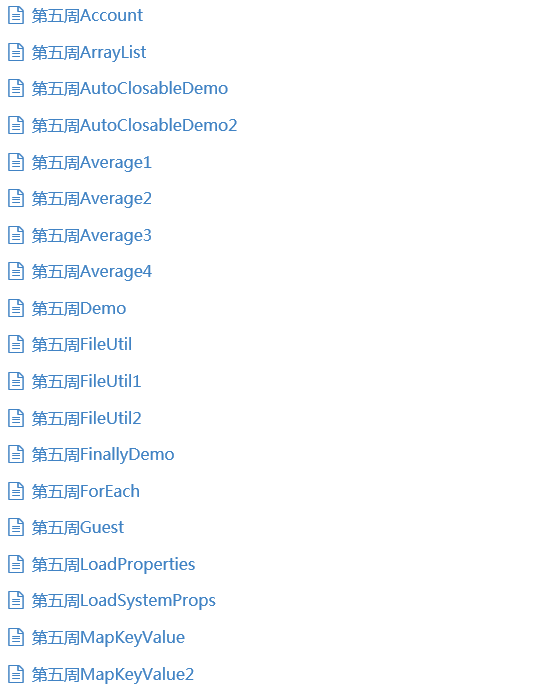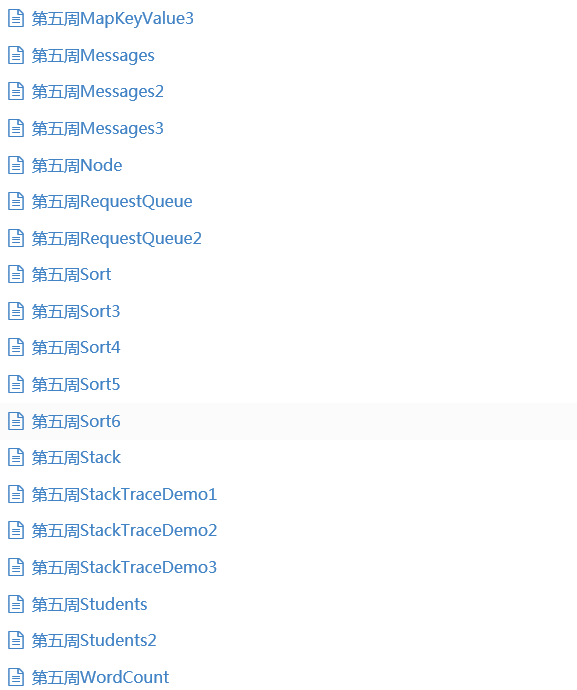20145216 《Java程序设计》第5周学习总结
教材学习内容总结
第八章 异常处理
8.1 语法与继承架构
-
Java中所有错误都会被打包为对象,运用try、catch,可以在错误发生时显示友好的错误信息。如:
import java.util.*; public class Average2 { public static void main(String[] args) { try { Scanner console = new Scanner(System.in); double sum = 0; int count = 0; while (true) { int number = console.nextInt(); if (number ==0) { break; } sum += number; count++; } System.out.printf("平均 %.2f%n",sum / count); } catch (InputMismatchException ex) { System.out.println("必须输入整数"); } } } -
运用try、catch,还可以在捕捉处理错误之后,尝试恢复程序正常执行流程。如:
import java.util.*; public class Average3 { public static void main(String[] args) { Scanner console = new Scanner(System.in); double sum = 0; int count = 0; while (true) { try { int number = console.nextInt(); if (number == 0) { break; } sum += number; count++; } catch (InputMismatchException ex) { System.out.printf("略过非整数输入:%s%n", console.next()); } } System.out.printf("平均 %.2f%n", sum / count); } } -
如果父类异常对象在子类异常前被捕捉,则catch子类异常对象的区块将永远不会被执行。
-
catch括号中列出的异常不得有继承关系,否则会发生编译错误。
-
在catch区块进行完部分错误处理之后,可以使用throw(注意不是throws)将异常再抛出。如:
import java.io.*; import java.util.Scanner; public class FileUtil { public static String readFile(String name) throws FileNotFoundException { StringBuilder text = new StringBuilder(); try { Scanner console = new Scanner(new FileInputStream(name)); while (console.hasNext()) { text.append(console.nextLine()) .append(' '); } } catch (FileNotFoundException ex) { ex.printStackTrace(); throw ex; } return text.toString(); } } -
如果抛出的是受检异常,表示你认为客户端有能力且应该处理异常,此时必须在方法上使用throws声明;如果抛出的异常是非受检异常,表示你认为客户端调用方法的时机错了,抛出异常是要求客户端修正这个漏洞再来调用方法,此时也就不用throws声明。
-
如果使用继承时,父类某个方法声明throws某些异常,子类重新定义该方法时可以:
不声明throws任何异常。 throws父类该方法中声明的某些异常。 throws父类该方法中声明异常的子类。
但是不可以:
throws父类方法中未声明的其他异常。
throws父类方法中声明异常的父类。
-
在多重方法调用下,异常发生点可能是在某个方法之中,若想得知异常发生的根源,以及多重方法调用下的堆栈传播,可以利用异常对象自动收集的堆栈追踪来取得相关信息,例如调用异常对象的printStackTrace()。如:
public class StackTraceDemo1 { public static void main(String[] args) { try { c(); } catch (NullPointerException ex) { ex.printStackTrace(); } } static void c() { b(); } static void b() { a(); } static String a() { String text = null; return text.toUpperCase(); } } -
要善用堆栈追踪,前提是程序代码中不可有私吞异常的行为。
-
在使用throw重抛异常时,异常的追踪堆栈起点,仍是异常的发生根源,而不是重抛异常的地方。如:
public class StackTraceDemo2 { public static void main(String[] args) { try { c(); } catch (NullPointerException ex) { ex.printStackTrace(); } } static void c() { try { b(); } catch (NullPointerException ex) { ex.printStackTrace(); throw ex; } } static void b() { a(); } static String a() { String text = null; return text.toUpperCase(); } } -
程序执行的某个时间点或某个情况下,必然处于或不处于何种状态,这是一种断言。
-
何时该使用断言?
断言客户端调用方法前,已经准备好某些前置条件(通常在private方法之中) 断言客户端调用方法后,具有方法承诺的结果。 断言对象某个时间点下的状态。 使用断言取代批注。 断言程序流程中绝对不会执行到的程序代码部分。 -
断言是判定程序中的某个执行点必然是或不是某个状态,所以不能当作像if之类的判断式来使用,assert不应当作程序执行流程的一部分。
-
若想最后一定要执行关闭资源的动作,try、catch语法可以搭配finally,无论try区块中有无发生异常,若撰写有finally区块,则finally区块一定会被执行。如:
import java.io.*; import java.util.Scanner; public class FileUtil { public static String readFile(String name) throws FileNotFoundException { StringBuilder text = new StringBuilder(); Scanner console = null; try { console = new Scanner(new FileInputStream(name)); while (console.hasNext()) { text.append(console.nextLine()) .append(' '); } } finally { if(console != null) { console.close(); } } return text.toString(); } } -
如果程序撰写的流程中先return了,而且也有finally区块,那finally区块会先执行完后,再讲将值返回。如:
public class FinallyDemo { public static void main(String[] args) { System.out.println(test(true)); } static int test(boolean flag) { try { if(flag) { return 1; } } finally { System.out.println("finally..."); } return 0; } } -
尝试关闭资源语法:想要尝试自动关闭资源的对象,是撰写在try之后的括号中,如果无须catch处理任何异常,可以不用撰写,也不用撰写finally自行尝试关闭资源。如:
import java.io.FileInputStream; import java.io.FileNotFoundException; import java.util.Scanner; public class FileUtil2 { public static String readFile(String name) throws FileNotFoundException { StringBuilder text = new StringBuilder(); try(Scanner console = new Scanner(new FileInputStream(name))) { while (console.hasNext()) { text.append(console.nextLine()) .append(' '); } } return text.toString(); } } -
尝试关闭资源语法可套用的对象,必须操作java.lang.AutoCloseable接口。如:
public class AutoClosableDemo { public static void main(String[] args) { try(Resource res = new Resource()) { res.doSome(); } catch(Exception ex) { ex.printStackTrace(); } } } class Resource implements AutoCloseable { void doSome() { System.out.println("作一些事"); } @Override public void close() throws Exception { System.out.println("資源被關閉"); } } -
尝试关闭资源语法也可以同时关闭两个以上的对象资源,只要中间以分号分隔。如:
import static java.lang.System.out; public class AutoClosableDemo2 { public static void main(String[] args) { try(ResourceSome some = new ResourceSome(); ResourceOther other = new ResourceOther()) { some.doSome(); other.doOther(); } catch(Exception ex) { ex.printStackTrace(); } } } class ResourceSome implements AutoCloseable { void doSome() { out.println("作一些事"); } @Override public void close() throws Exception { out.println("資源Some被關閉"); } } class ResourceOther implements AutoCloseable { void doOther() { out.println("作其它事"); } @Override public void close() throws Exception { out.println("資源Other被關閉"); } } -
在try的括号中,越后面撰写的对象资源会越早被关闭。
第九章 Collection与Map
9.1 使用Collection收集对象
-
收集对象的行为,像是新增对象的add()方法、移除对象的remove()方法等,都是定义在java.util.Collection中。既然可以收集对象,也要能逐一取得对象,这就是java.lang.Iterable定义的行为,它定义了iterator()方法返回java.lang.Iterable操作对象,可以让你逐一取得收集的对象。
-
收集对象的共同行为定义在Collection中,然而收集对象会有不同的需求。如果希望收集时记录每个对象的索引顺序,并可依索引取回对象,这样的行为定义在java.util.List接口中。如果希望收集的对象不重复,具有集合的行为,则由java.util.Set定义。如果希望收集对象时以队列方式,收集的对象加入至尾端,取得对象时从前端,则可以使用java.util.Queue。如果希望Queue的两端进行加入、移除等操作,则可以使用java.util.Deque。
-
List是一种Collection,作用是收集对象,并以索引方式保留收集的对象顺序,其操作类之一是java.util.ArrayList。如:
import java.util.*; import static java.lang.System.out; public class Guest { public static void main(String[] args) { List names = new java.util.ArrayList(); collectNameTo(names); out.println("訪客名單:"); printUpperCase(names); } static void collectNameTo(List names) { Scanner console = new Scanner(System.in); while(true) { out.print("訪客名稱:"); String name = console.nextLine(); if(name.equals("quit")) { break; } names.add(name); } } static void printUpperCase(List names) { for(int i = 0; i < names.size(); i++) { String name = (String) names.get(i); out.println(name.toUpperCase()); } } } -
数组在内存中会是连续的线性空间,根据索引随机存取时速度快,如果操作上有这类需求时,像是排序,就可使用ArrayList,可得到较好的速度表现。
-
LinkedList在操作List接口时,采用了链接(Link)结构。
-
若收集的对象经常会有变动索引的情况,也许考虑链接方式操作的List会比较好,像是随时会有客户端登录或注销的客户端List,使用LinkedList会有比较好的效率。
-
在收集过程中若有相同对象,则不再重复收集,如果有这类需求,可以使用Set接口的操作对象。如:
import java.util.*; public class WordCount { public static void main(String[] args) { Scanner console = new Scanner(System.in); System.out.print("請輸入英文:"); Set words = tokenSet(console.nextLine()); System.out.printf("不重複單字有 %d 個:%s%n", words.size(), words); } static Set tokenSet(String line) { String[] tokens = line.split(" "); return new HashSet(Arrays.asList(tokens)); } } -
HashSet的操作概念是,在内存中开设空间,每个空间会有个哈希编码。
-
Queue继承自Collection,所以也具有Collection的add()、remove()、element()等方法,然而Queue定义了自己的offer()、poll()与peek()等方法,最主要的差别之一在于:add()、remove()、element()等方法操作失败时会抛出异常,而offer()、poll()与peek()等方法操作失败时会返回特定值。
-
如果对象有操作Queue,并打算以队列方式使用,且队列长度受限,通常建议使用offer()、poll()与peek()等方法。
-
LinkedList不仅操作了List接口,与操作了Queue的行为,所以可以将LinkedList当作队列来使用。如:
import java.util.*; interface Request { void execute(); } public class RequestQueue { public static void main(String[] args) { Queue requests = new LinkedList(); offerRequestTo(requests); process(requests); } static void offerRequestTo(Queue requests) { for (int i = 1; i < 6; i++) { Request request = new Request() { public void execute() { System.out.printf("處理資料 %f%n", Math.random()); } }; requests.offer(request); } } static void process(Queue requests) { while(requests.peek() != null) { Request request = (Request) requests.poll(); request.execute(); } } } -
想对队列的前端与尾端进行操作,在前端加入对象与取出对象,在尾端加入对象与取出对象,Queue的子接口Deque就定义了这类行为。
-
java.util.ArrayDeque操作了Deque接口,可以使用ArrayDeque来操作容量有限的堆栈。
-
泛型语法:类名称旁有角括号<>,这表示此类支持泛型。实际加入的对象是客户端声明的类型。如:
import java.util.Arrays; public class ArrayList<E> { Object[] elems; private int next; public ArrayList(int capacity) { elems = new Object[capacity]; } public ArrayList() { this(16); } public void add(E e) { if(next == elems.length) { elems = Arrays.copyOf(elems, elems.length * 2); } elems[next++] = e; } public E get(int index) { return (E) elems[index]; } public int size() { return next; } } -
相对于匿名类语法来说,Lambda表达式的语法省略了接口类型与方法名称,->左边是参数列,而右边是方法本体。
-
在Lambda表达式中使用区块时,如果方法必须有返回值,在区块中就必须使用return。
-
interator()方法提升至新的java.util.Iterable父接口。
-
Collections的sort()方法要求被排序的对象必须操作java.lang.Comparable接口,这个接口有个compareTo()方法必须返回大于0、等于0或小于0的数。
-
Collections的sort()方法有另一个重载版本,可接受java.util.Comparator接口的操作对象,如果使用这个版本,排序方式将根据Comparator的compare()定义来决定。如:
import java.util.*; class StringComparator implements Comparator<String> { @Override public int compare(String s1, String s2) { return -s1.compareTo(s2); } } public class Sort5 { public static void main(String[] args) { List<String> words = Arrays.asList("B", "X", "A", "M", "F", "W", "O"); Collections.sort(words, new StringComparator()); System.out.println(words); } } -
在java的规范中,与顺序有关的行为,通常要不对象本身是Comparable,要不就是另行指定Comparator对象告知如何排序。
-
若要根据某个键来取得对应的值,可以事先利用java.util.Map接口的操作对象来建立键值对应数据,之后若要取得值,只要用对应的键就可以迅速取得。常用的Map操作类为java.util.HashMap与java.util.TreeMap,其继承自抽象类java.util.AbstractMap。
-
Map也支持泛型语法,如使用HashMap的范例:如:
import java.util.*; import static java.lang.System.out; public class Messages { public static void main(String[] args) { Map<String, String> messages = new HashMap<>(); messages.put("Justin", "Hello!Justin的訊息!"); messages.put("Monica", "給Monica的悄悄話!"); messages.put("Irene", "Irene的可愛貓喵喵叫!"); Scanner console = new Scanner(System.in); out.print("取得誰的訊息:"); String message = messages.get(console.nextLine()); out.println(message); out.println(messages); } } -
如果使用TreeMap建立键值对应,则键的部分则会排序,条件是作为键的对象必须操作Comparable接口,或者是在创建TreeMap时指定操作Comparator接口的对象。如:
import java.util.*; public class Messages2 { public static void main(String[] args) { Map<String, String> messages = new TreeMap<>(); messages.put("Justin", "Hello!Justin的訊息!"); messages.put("Monica", "給Monica的悄悄話!"); messages.put("Irene", "Irene的可愛貓喵喵叫!"); System.out.println(messages); } } -
Properties类继承自Hashtable,HashTable操作了Map接口,Properties自然也有Map的行为。虽然也可以使用put()设定键值对应、get()方法指定键取回值,不过一般常用Properties的setProperty()指定字符串类型的键值,getProperty()指定字符串类型的键,取回字符串类型的值,通常称为属性名称与属性值。
-
如果想取得Map中所有的键,可以调用Map的keySet()返回Set对象。由于键是不重复的,所以用Set操作返回是理所当然的做法,如果想取得Map中所有的值,则可以使用values()返回Collection对象。如:
import java.util.*; import static java.lang.System.out; public class MapKeyValue { public static void main(String[] args) { Map<String, String> map = new HashMap<>(); map.put("one", "一"); map.put("two", "二"); map.put("three", "三"); out.println("顯示鍵"); map.keySet().forEach(key -> out.println(key)); out.println("顯示值"); map.values().forEach(key -> out.println(key)); } } -
如果想同时取得Map的键与值,可以使用entrySet()方法,这会返回一个Set对象,每个元素都是Map.Entry实例。可以调用getKey()取得键,调用getValue()取得值。如:
import java.util.*; public class MapKeyValue2 { public static void main(String[] args) { Map<String, String> map = new TreeMap<>(); map.put("one", "一"); map.put("two", "二"); map.put("three", "三"); foreach(map.entrySet()); } static void foreach(Iterable<Map.Entry<String, String>> iterable) { for(Map.Entry<String, String> entry: iterable) { System.out.printf("(鍵 %s, 值 %s)%n", entry.getKey(), entry.getValue()); } } }
教材学习中的问题和解决过程
问题1:
Error与Exception的区别:
解决过程:
通过反复看教材,我总结出了以下区别:
Error与其子类实例代表严重系统错误,如硬件层面错误、JVM错误或内存不足等问题,虽然也可以使用try、catch来
处理Error对象,但并不建议,发生严重系统错误时,Java应用程序本身是无力回复的。
Exception或其子类实例代表程序设计本身的错误,所以通常称错误处理为异常处理(Exception Handling)。
问题2:
Exception与RuntimeException的区别:
解决过程:
教材中对Exception与RuntimeException有所解释,但是我并没有完全理解二者的区别,于是我通过上网查资料,总结出以下区别:
Exception:在程序中必须使用try、catch进行处理。
RuntimeException:可以不使用try、catch进行处理,但是如果有异常产生,则异常将由JVM进行处理。
归纳总结:
异常的继承结构:基类为Throwable,Error和Exception继承Throwable,RuntimeException和IOException
等继承Exception。
Exception或其子对象,但非属于RuntimeException或其子对象,称为受检异常;属于RuntimeException衍生出
来的类实例,称为非受检异常。
代码调试中的问题和解决过程
问题:
书上p233页的代码范例中的“!input.matches("\d*")”是什么意思?
解决过程:
通过看书上对代码的解析,得到如下解释:String 的 matches() 方法中设定了"\d*",这是规则表示式,表示检查字符串中的字符是不是数字,若是则 matches() 会返回true。
其他(感悟、思考等,可选)
本周学习了第八、第九章,给我留下的最深刻的印象就是各种类、接口、方法、行为越来越多,有些还很相似,结果经常分不清楚,看到后面的内容又忘记了前面的知识点,学习时一直前后反复翻教材,后来我就尝试做笔记,将重要的、容易混淆的知识点都记下来,发现这样在回顾知识点时很方便,也很清晰明了。虽然这周学习效率不是很高,但是通过对这两章内容的学习,我体会到勤于做笔记和总结对学习是一个很有效的方法。
托管代码截图:



学习进度条
| 代码行数(新增/累积) | 博客量(新增/累积) | 学习时间(新增/累积) | 重要成长 | |
|---|---|---|---|---|
| 目标 | 4500行 | 30篇 | 350小时 | 能将java运用自如 |
| 第一周 | 150/150 | 2/2 | 15/15 | 学习了与java相关的基础知识 |
| 第二周 | 200/350 | 1/3 | 20/35 |
学习了java的基本语法 |
| 第三周 | 450/800 | 1/4 | 25/60 |
学习了对象和封装的相关知识 |
| 第四周 | 687/ 1487 | 1/5 | 30/90 |
学习了继承与接口的相关知识 |
| 第五周 | 803/2290 | 1/6 | 30/120 |
学习了异常处理以及Collection与Map的相关知识 |